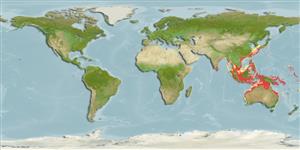Echinoidea |
Camarodonta |
Temnopleuridae
Environment: milieu / climate zone / пределы глубины / distribution range
экология
; пределы глубины 0 - 124 m (ссылка 95661). Tropical
Indo-West Pacific: China to Solomon Islands and Australia.
Length at first maturity / Size / Weight / Возраст
половая зрелость: Lm ? range ? - ? cm
Shape varies from oval to conical. Spines are short and thin, with those nearer the oral surface being broad and flat. Color varies from white to olive green. Spines are green with reddish-brown, purple, white, or green brands.
Maximum spine length: 1.5 cm. Inhabits shallow seagrass beds but can also be found at depths 90 m. Covers itself with debris or shells for camouflage purposes (Ref. 800). Omnivore. Feed on algae and small soft-bodied organisms (Ref. 125532).
Life cycle and mating behavior
половая зрелость | размножение | нерест | Eggs | Fecundity | Larvae
Members of the class Echinoidea are gonochoric. Fertilization is external. Brooding is common, eggs are held either on the peristome, around the periproct or deep into the concavities on the petaloids. Life cycle: Embryos develop into planktotrophic larvae (echinoplateus) and live for several months before they sink to the bottom using their tube feet to adhere on the ground where they metamorphose into young urchins.
Основная ссылка
ссылки | координатор | соавторы
Schoppe, S. 2000 A guide to common shallow water sea stars, brittle stars, sea urchins, sea cucumbers and feather stars (echinoderms) of the Philippines. Times Media Private Limited, Singapore. 144 p. (ссылка 800)
Статус Красного Списка МСОП
(ссылка 130435: Version 2025-1)
Статус СИТЕС (ссылка 108899)
Not Evaluated
CMS (ссылка 116361)
Not Evaluated
Угроза для людей
Harmless
Использование человеком
| FishSource |
инструменты
дополнительная информация
Trophic EcologyFood items (preys)
состав пищи
потребление пищи
хищники
Population dynamicsрост
Max. ages / sizes
Length-weight rel.
Length-length rel.
Размерный состав
Mass conversion
численность
Life cycleразмножениеполовая зрелостьFecundityнерестEggsРазвитие икрыLarvae PhysiologyOxygen consumption
Human RelatedStamps, coins, misc.
ресурсы в Интернет
Estimates based on models
Preferred temperature
(Ref.
115969): 24.5 - 29, mean 28.1 (based on 1412 cells).
Категория цены
Unknown.
